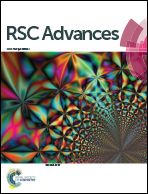Silver nanoparticle aggregates by room temperature electron reduction: preparation and characterization
Abstract
A step-by-step room temperature electron reduction has been developed in this work to prepare silver nanoparticle aggregates on anodic aluminium oxide (AAO) substrate. No chemical reducing agent is needed. The aggregates are formed by silver nanoparticles with a particle size of about 3 nm. The colour of the silver nanoparticle aggregates can be adjusted from yellow (with small Ag loading) to dark (with high Ag loading). Especially, the colour of these aggregates depends on the size of the Ag nanoparticle aggregate, rather than on the size of the single Ag nanoparticles. The silver aggregate/AAO composites show an outstanding surface plasmon resonance (SERS) characteristic. The Raman enhancement factor reaches as high as 1.054 × 107. The silver nanoparticle aggregates can be dispersed as Ag nanoparticles within a liquid solution with the removal of the substrate under the assistance of ultrasonic dispersion. The silver nanoparticle aggregates obtained by this step-by-step electron reduction provide a convenient and sustainable means for the storage of metal nanoparticles.


 Please wait while we load your content...
Please wait while we load your content...